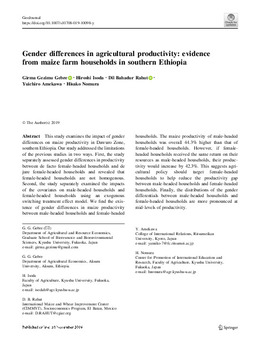Gender differences in agricultural productivity: evidence from maize farm households in southern Ethiopia
Abstract
This study examines the impact of gender differences on maize productivity in Dawuro Zone, southern Ethiopia. Our study addressed the limitations of the previous studies in two ways. First, the study separately assessed gender differences in productivity between de facto female-headed households and de jure female-headed households and revealed that female-headed households are not homogenous. Second, the study separately examined the impacts of the covariates on male-headed households and female-headed households using an exogenous switching treatment effect model. We find the existence of gender differences in maize productivity between male-headed households and female-headed households. The maize productivity of male-headed households was overall 44.3% higher than that of female-headed households. However, if female-headed households received the same return on their resources as male-headed households, their productivity would increase by 42.3%. This suggests agricultural policy should target female-headed households to help reduce the productivity gap between male-headed households and female-headed households. Finally, the distributions of the gender differentials between male-headed households and female-headed households are more pronounced at mid-levels of productivity.

